DAUNTING DRAGONFLIES OF THE DEMONIC, HORSE-HEADED, AND BROBDINGNAGIAN VARIETIES!
My very own giant dragonfly, chanced upon in a charity shoprecently and now residing in my study (© Dr Karl Shuker)
This ShukerNature blog article of minedocuments an entomological enigma of the cryptozoological kind that has longfascinated, me but which I've never previously blogged about. Namely, the extraordinarypossibility that extra-large dragonflies, veritable giants in some cases, existunrecognised by science in our modern-day world. Consequently, I have gatheredhere an exclusive selection of such reports for your perusal. First of all,however, I'd like to set the scene for them by presenting a couple of comparableexamples plucked from traditional folklore and medieval fancy.
GIANTDRAGONFLIES IN FOLKLORE
On 16 August 2015, I documented here onShukerNature (and subsequently redocumented in expanded form within the firstof my ShukerNature compendium books, ShukerNature Book 1: Antlered Elephants, LocustDragons, and Other Cryptic Blog Beasts, 2019), a fascinating but thoroughly bafflingcenturies-old engraving illustrating a mysterious beast so bizarre inappearance that I dubbed it the locust dragon (click hereto view my original blog article concerning it).
The original source of this specificengraving was a series of prints produced in Antwerp, Belgium, by Flemishengraver Nicolaes de Bruyn (1571-1656) in 1594 that depicted various flyingcreatures.
Although he is best known for his manybiblically-themed engravings and his large engraved landscapes reproducingdesigns and paintings by other artists, de Bruyn produced approximately 400works in total, including a number that featured animals.
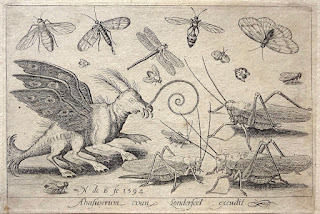 Nicolaes de Bruyn'smystifying engraving from 1594, depicting a wide range of readily-identifiableinsects, plus what can only be described as a truly bizarre 'locust dragon'(public domain)
Nicolaes de Bruyn'smystifying engraving from 1594, depicting a wide range of readily-identifiableinsects, plus what can only be described as a truly bizarre 'locust dragon'(public domain)
The series containing the locust dragon wasentitled Volatilium Varii Generis Effigies ('Pictures of Flying Creaturesof Varied Kinds'), and was first published by Ahasuerus van Londerseel(1572-1635) of Amsterdam.
It was subsequently reissued (with vanLonderseel's name neatly trimmed off!) by Carel Allard in 1663 (or shortlyafter – there are conflicting accounts concerning this detail).
My investigation of what the locust dragonmight conceivably have been attracted a number of replies from readers, postedbeneath my blog article, including one whose subject was entirely new to me andvery intriguing.
Posted on 30 August 2015 by a reader withthe memorable Google username Dracula van Helsing, it mentioned that de Bruyn'sgrotesque locust dragon reminded him of a legend from Cantabria, a region innorthern Spain, concerning certain horse-like demonic dragonflies known asCaballucos (aka Caballitos) del Diablu ('little horses of the devil', despitebeing said to be at least as big as real horses!).
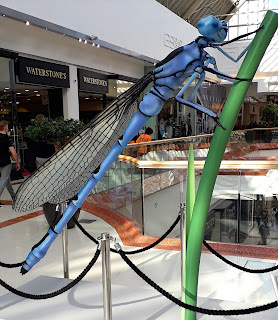 Giant model of a southern damselfly Coenagrion mercuriale, a very eyecatching species of slender-bodieddragonfly native to Britain and several countries across mainland Europe (© DrKarl Shuker)
Giant model of a southern damselfly Coenagrion mercuriale, a very eyecatching species of slender-bodieddragonfly native to Britain and several countries across mainland Europe (© DrKarl Shuker)
Here is Wikipedia's then-current entry onthese very intriguing yet little-known mythical beasts, which has since beenreworded somewhat and expanded (see also below), but was originally derivedfrom Manuel LlanoMerino's book Mitos y Leyendas de Cantabria, published in 2001:
On St John's Eve (June 23), when the peoplemake bonfires to purify their souls, giant dragonflies appear amongst theashes. These dragonflies - the Caballucos - are the souls of sinners, and theycome to release their fury over a year's worth of sins with fire and terrifyingscreams.
The Caballucos del Diablu appear in avariety of colors, each one being the soul of a different sinner. The red horsewas a man who lent money to farmers and then used dirty tricks to steal theirproperties; the white one a miller who stole many thousands of dollars from hismaster; the black one a hermit who played tricks on people; the yellow one acorrupt judge; the blue one an innkeeper; and the orange one a child who abusedhis parents.
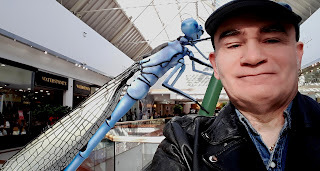 Worryinglyclose to a giant damselfly! (© Dr Karl Shuker)
Worryinglyclose to a giant damselfly! (© Dr Karl Shuker)
And here is this entry's present version, i.e. as oftoday, 28 November 2023:
On St John's Eve (June 23)at night; when the people make bonfires to purify their souls, horses(Percheron purebred) with damselfly wings [damselflies are slender-bodieddragonfly species], black manes and foaming mouths appear amongst the ashes.These stallions – the Caballucos – are the souls of sinners, damned to roamCantabria for eternity, come to release their fury over a year's worth of sins,creating a rumbling explosion with fire accompanied by terrifying screams.
The Caballucos del Diabluappear in a variety of colors, each one being the soul of a different sinner,as legends highlight. The red horse was a man who lent money to farmers andthen used dirty tricks to steal their properties; the white one a miller whostole many thousands of dollars from his master; the black one a hermit whoplayed tricks on people; the yellow one a corrupt judge; the blue one aninnkeeper; and the orange one a child who abused his parents;[1] the green one a lord who possessedmany lands and dishonoured plenty of young women. It is said that the Devilhimself roams the streets riding the red fire-breathing steed, the sturdiestand most powerful who leads the raid, while other demons ride the rest. Theforce in their stomping is such that their horseshoes leave prints on rocks, asif they were freshly ploughed soil. They have gleaming eyes, and blow a strongwind with their nostrils to try impeding lovers from giving corsages to thegirls. The huffs, as cold as winter, are strong enough to make leaves fall fromtrees and bushes. The horses’s food are shamrocks, with they eat tastefully,probably to prevent the seekers who come out at night from finding any. TheCaballucos pounce on everyone they come across, the only things that repelsthem is a bunch of vervain that the person can carry along; the plant has to becollected the day before though, or should be placed next to St John’s fire, towhich they won’t come near. The locals note that sometimes, after becoming wornout by the search, the Caballucos stop to rest and their saliva drips on theground, and turns into gold ingots. Whoever takes them will be made extremelywealthy, but will descent straight to hell after death.
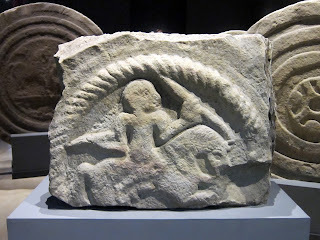 Obverseside of
a stele(carved upright stone) from San Vicente de Toranzo (Cantabria), depicting aridden Cabulluco del Diablu, and displayed at the Museum of Prehistory andArchaeology of Cantabria, Spain (© Valdavia/Wikipedia –
CC BY-SA 3.0 licence
)
Obverseside of
a stele(carved upright stone) from San Vicente de Toranzo (Cantabria), depicting aridden Cabulluco del Diablu, and displayed at the Museum of Prehistory andArchaeology of Cantabria, Spain (© Valdavia/Wikipedia –
CC BY-SA 3.0 licence
)
Yet although giant dragonflies of equine appearance wouldundoubtedly be eyecatching in their own right if such creatures ever existed inreality as opposed to mere mythology, they would not bear any tangibleresemblance to the enigmatic entity upon which my locust dragon investigationshave been focused.
Interestingly, what has been described by some writers asa four-legged, horse-headed dragonfly is also portrayed in the LuttrellPsalter, an English illuminated manuscript dating from c.1325-1340.
However, as can readily be perceived here, theillustration of this incongruous insect bears no resemblance to those of thelocust dragon.
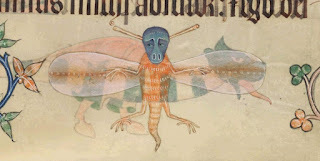 A four-legged, horse-headed dragonflydepicted in the Luttrell Psalter (public domain)
A four-legged, horse-headed dragonflydepicted in the Luttrell Psalter (public domain)
Butthat is still not all as far as controversial giant dragonflies ordragonfly-like mystery beasts of the decidedly daunting kind are concerned.
GIANT DRAGONFLIES IN FACT?
Oneof the fantastical lands visited by physician Dr Lemuel Gulliver in JonathanSwift's famous satirical fantasy novel Gulliver'sTravels (1726) is Brobdingnag, a remote, hitherto-unexplored peninsula ofthe western USA, whose human inhabitants and wildlife are all of giganticproportions.
Accordingly,in real life the adjective 'Brobdingnagian' is often applied to anything ofextraordinarily large size – and could therefore be definitely applied inrelation to certain reports in the cryptozoology archives of supposedly realbut unequivocally oversized dragonflies.
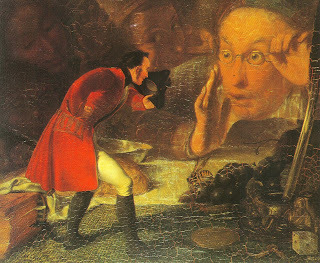 A painting ofGulliver being inspected by one of the giants of Brobdingnag – note theenormous wasp in the foreground! (public domain)
A painting ofGulliver being inspected by one of the giants of Brobdingnag – note theenormous wasp in the foreground! (public domain)
One ofthese was posted on Lon Strickler's Phantoms and Monsters website, and reads as follows:
Me and my younger brothersaw a huge dragonfly spanning well over a foot and half long in Bolton, Englandin 2002. It must have been over an inch in diameter as well at the centre. Iwould have questioned myself but as it was witnessed by someone else too. I’mpretty sure it wasn’t just me seeing things. Sometimes I think was it an RC [radio/remote-controlled]helicopter? But no way could it move with such swiftness, agility and silenceespecially with 2002 technology. I went to the Manchester museum and checkedwith the insect experts and they said it sounds like you’ve seen something fromthe prehistoric and that no species of dragonfly that exist today are thatlarge. It’s not a giant bird but has anyone ever seen these massivedragonflies? I would love some confirmation some more witnesses across theworld.
Twoyears after this sighting, two comparable ones were posted online in the forumof the Charles Fort Institute's website on the very same day, 25 July 2004. Oneof these was posted by someone I know personally, a well-respected naturalistnamed Oll Lewis. Here is his typically matter-of-fact account of his encounter,which took place in the Vale of Glamorgan, Wales:
I have seen a largedragonfly before, I live near a large country park with 2 huge lakes andextensive reed beds so if there were an ideal place for dragonfly and damselflyspotting, that's it. The largest dragonfly I observed was in Cosmeston LakesCountry Park [and] had a wingspan of at least 1/2 a meter [50 cm] skimming overthe surface of the lake about 3 metres from the bank. It was brownish yellow incolour and apart from its size quite unremarkable.
 A view of Cosmeston LakesNational Park (© Nagezna/Wikipedia –
CC BY-SA 4.0 licence
)
A view of Cosmeston LakesNational Park (© Nagezna/Wikipedia –
CC BY-SA 4.0 licence
)
Isubsequently learned from Oll that he had reported his sighting to auniversity-based entomology professor, who blithely discounted it. Thelongest-bodied dragonfly native to the UK is the golden-ringed dragonfly Cordulegaster boltonii, whose slenderelongate body can reach almost 8.5 cm long in adult females with fully-formedovipositors, and whose wingspan can be as much as 10 cm, The largest UKdragonfly species in terms of wingspan is the emperor dragonfly Anax imperator, whose body averagesaround 8 cm long but its wingspan is up to 10.5 cm. However, these species'impressive dimensions still fall far short of those for the two mystery Britishspecimens described above.
Thesecond Charles Fort Institute forum report was posted by a contributor with theusername laphip. Here it is:
When I was around nineyears old me and my two sisters watched a dragonfly with a body about half ametre long circle around our backyard just above the height of our bungalow (inEdmonton, Alberta, Canada). When we told our mom about it, she just said itmust've been a toy plane shaped like a dragonfly. It looked quite naturally aninsect to me, and it made no sound. Would a dragonfly of that size make or notmake noise in flight? Can toy remote controlled planes be soundless?
Due totheir rapid aerial movements and continual hawking, the size of these insectsis notoriously difficult to gauge accurately, especially by eyewitnesses notfamiliar with them. So overestimation of size would not be difficult. Havingsaid that, the above-noted mentions of remote/radio-controlled aircraft maywell be relevant, especially in light of an unexpected but fascinatingdiscovery that I made recently, and which I'll reveal later here.
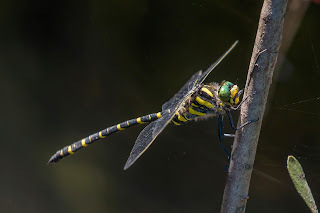 Golden ringed dragonfly Cordulegaster boltonii, male (© CharlesJ Sharp/Wikipedi –
CC BY-SA 4.0 licence
)
Golden ringed dragonfly Cordulegaster boltonii, male (© CharlesJ Sharp/Wikipedi –
CC BY-SA 4.0 licence
)
Anotherreport, forwarded to me in 2001 by Strange Magazine's founding editor,the late Mark Chorvinsky, consists of a report e-mailed to him by correspondentVictor Engel. It reads as follows:
You may be interested in an expedition I plan on this summer. InMay/June 1974 while driving through Mexico, I saw the largest dragonfly I'veever seen. At the time I estimated its wingspan at 14 inches. Since that time,I've not seriously searched for it again, but I have done some research. I'vecontacted dragonfly experts and other insect experts. The general consensus inthe scientific community is that while there used to be dragonflies of thatsize, and, in fact, even larger, they don't, and cannot exist today. The reasoncited for believing they cannot exist today is that the oxygen content of theatmosphere is too low to support the high metabolism required for the dragonflyto catch its prey. Then I got in touch with Dr Gilbert, of the University ofTexas at Austin, who is doing research with imported fire ants and theirparasitic phorid flies. He gave me two well thought-out lists. One was a listof all the reasons why such a dragonfly cannot exist. The other was a list ofreasons why such an insect could possibly exist. Anyway, I'm so convinced atwhat I saw in the 70s that now I'm making a special trip just to find oneagain.
AsEngel correctly mentions, back in ancient prehistoric times there were dragonflies– or, to be precise, dragonfly-resembling insects – that were even bigger thanthe size estimate offered by him for his Mexican mystery specimen. Theseveritable giants are known as griffinflies, in homage to those legendary wingedmonsters the griffins, Originally housed together with the true dragonflies anddamselflies within the taxonomic order Odonata, griffinflies are nowadayshoused in a separate, extinct order, Meganisoptera.
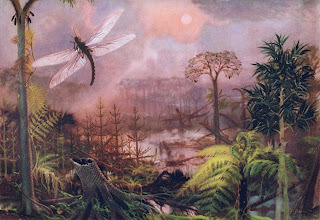 Griffinfly in prehistoricscene, vintage illustration (public domain)
Griffinfly in prehistoricscene, vintage illustration (public domain)
Indeed,fossil remains of Meganeura monyi, a dragonfly that lived approximately300 million years ago during the late Carboniferous Era in what is todayFrance, indicate that it sported a spectacular wingspan of up to 29.5 in.
Moreover,Meganeuropsis permiana, living duringthe early Permian Era, sported a comparable wingspan, thereby making these thelargest insect species, past or present, currently known to science.
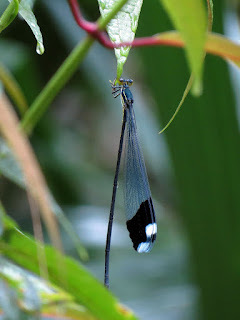 Giant blue damselfly Megalopropus caeruleata (© Katja Schulz/Wikipedia–
CC BY 2.0 licence
)
Giant blue damselfly Megalopropus caeruleata (© Katja Schulz/Wikipedia–
CC BY 2.0 licence
)
Today,conversely, the largest Odonata member is the giant blue damselfly Megalopropuscaeruleata, a damselfly native to Central and South America, whose wingspanmeasures up to 7.52 in, and whose body length is up to 4.72 in. Hence Engel'sspecimen, if accurately estimated, would have a wingspan twice this.
In aJournalnewsOnline article of 15 February 2022, veteran mystery beastinvestigator Brent Swancer recalled being told by a supposed giant dragonflyeyewitness that he and a friend had been hiking together through Florida'sfamous Everglades National Park on a clear day when they saw what seemed atfirst to be a bird, but then they saw that it had four beating wings, not two, andthat its metallic green body was very elongate, measuring over 1 ft long.Moreover, as they watched, the creature came close enough for them to discernthe multi-faceted form of its eyes, as characteristically exhibited by thecompound eyes of adult insects, hovering in front of them for a moment beforeit swooped off again, its flight entirely silent throughout.
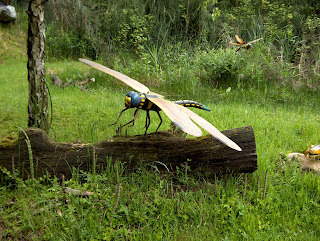 Scale model of a griffinfly(© GermanOle/Wikipedia –
CC BY-SA 3.0 licence
)
Scale model of a griffinfly(© GermanOle/Wikipedia –
CC BY-SA 3.0 licence
)
It iswell known that the tracheal-based respiratory system of insects, whoseinternal network of minute cell-penetrating, air-transporting tubes is onlycapable of transporting oxygen over tiny distances, precludes these creaturesfrom attaining the gargantuan sizes beloved of sci-fi movie makers, and even fromthose attained by the long-demised griffinflies, as the oxygen content of theatmosphere that existed way back in their time was much greater than it istoday.
Bearingthis in mind, therefore, what on earth – or anywhere else, for that matter! –can we say about the absolutely ginormous dragonfly lookalikes that a readerwith the username PoeticsOfBigfoot posting to the cryptozoology websiteCryptomundo on 28 June 2013 claimed to have observed over a lengthy period oneevening in, fittingly, Texas?
Giant insects are more common in the Southwest than peoplerealize. I saw huge dragonfly-like insects around sundown near Terlingua TXonce. I estimate they were eight feet long or so, with about the same wingspan.They had some sort of long whip-like appendage at their posterior end, a littlelonger than their bodies, that arced upward. I saw three of them over atwo-hour time span.
 Confronted bya monster dragonfly sculpture of truly monstrous proportions in Wroclaw, Poland(© PiotrPrzybyszewski/Wikipedia –
CC BY 3.0 licence
)
Confronted bya monster dragonfly sculpture of truly monstrous proportions in Wroclaw, Poland(© PiotrPrzybyszewski/Wikipedia –
CC BY 3.0 licence
)
Maledragonflies do possess a pair of claspers at the tip of their most posteriorabdominal segment, and females bear a single circus there, but these arenowhere near as long as the insects' bodies. So too did griffinflies, but withthe same proviso. Moreover, for the respiratory reasons mentioned above, an8-ft-long insect living today, most especially one as metabolically active as afast-flying dragonfly, would be a physiological impossibility.
Andeven if it wasn't, such a spectacular, readily visible entity native to NorthAmerica would assuredly have been discovered, described, and fully documentedby science long ago. So although dragonflies are predatory, I wouldn't worryunduly about being dive-bombed any time soon by the terrorflies of Terlingua!
Unless,of course, this titanic trio had winged their way to Texas from Brobdingnag'ssecluded peninsula??? Gulliver's remarkable travels and his numeroushair-raising experiences during them had so transformed his personality thatafter he finally returned safely home, he became a recluse. After encounteringmonsters like these, can you blame him??
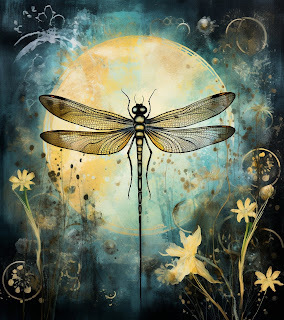 Fictional giantdragonfly with long whip-like posterior process like the three 8-ft-long Texasspecimens (public domain)
Fictional giantdragonfly with long whip-like posterior process like the three 8-ft-long Texasspecimens (public domain)
Seriously,however, I have recently learned to my surprise but delight that giantradio-controlled dragonfly models not only exist but be readily purchased oncertain websites – so might these fascinating fliers explain such sightings, includinglaphip's noted earlier here, especially if they were spied in dim lightconditions? Then again, eyewitnesses of such creatures have often claimed thattheir flight was totally silent, thus suggesting that they weren't remote-controlledaircraft or drones after all.
In short, unless we dismiss all suchreports as involving hoaxes, misidentifications of non-insect aerial creatures,or exaggerated size estimates of bona fide dragonflies, the mystery of thesegiant flying insects remains very much up in the air – as indeed do they!
Formy expanded coverage of the locust dragon, be sure to check out ShukerNatureBook 1, whose front cover sports a gorgeousfull-colour painting by longstanding friend and superb artist Anthony Walls, inwhich he portrays me with said locust dragon perching contentedly on myshoulder:
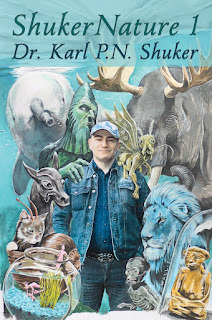
Karl Shuker's Blog
- Karl Shuker's profile
- 45 followers



